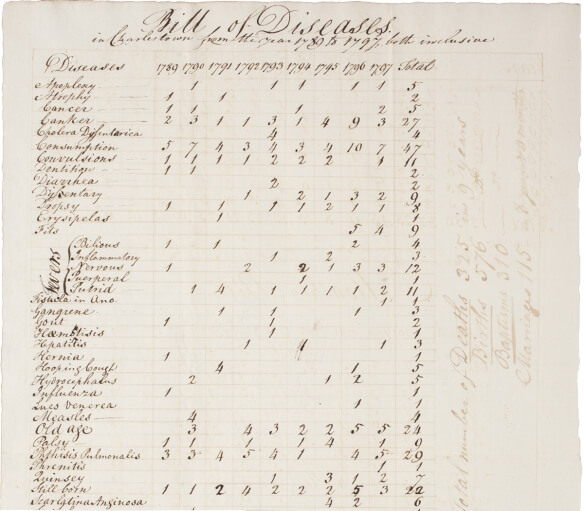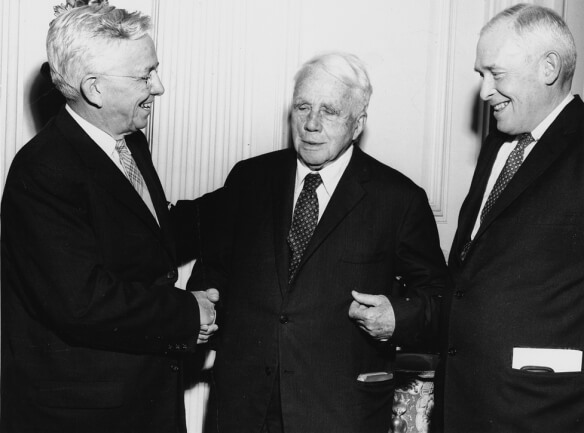Three Centuries in “Pursuit of Useful Knowledge”
The American Academy of Arts and Sciences existed before there was an American Constitution, before there was an American federal republic. Founded in 1780 in the midst of revolution, it is older than all but a handful of the learned bodies of this country. Indeed, few institutions in the United States today can claim such storied origins. The Academy’s transformation from a largely Boston-based institution to a unique national and international body, committed to intellectual activity in the broadest sense of the term, owes much to its ability to use its traditions imaginatively, and accepting and even promoting change. Yet the organization remains faithful always to a charter founded on eighteenth-century ideals that celebrate the life of the mind, ever proclaiming the arts and sciences to be “necessary to the interest, honor, dignity and happiness of a free, independent and virtuous people.”
FOUNDING
Inspired by Philadelphia’s American Philosophical Society, John Adams decided as early as 1776 to found a similar body in Boston. He took a central role in drafting a new constitution for Massachusetts, and in particular inserted an expansive section on the state’s obligation to nurture and support learning and economic development through the encouragement and promotion of institutions and other means. In this context, and in the midst of war, the American Academy of Arts and Sciences was established by the Commonwealth of Massachusetts on May 4, 1780, "to cultivate every art and science which may tend to advance the interest, honor, dignity, and happiness of a free, independent, and virtuous people." The sixty-two incorporating members were tasked by the charter to promote the growth of learning overall (including civil and natural history; mathematical, astronomical, and physical sciences; and medicine) and the application of knowledge in agriculture, commerce, and other areas — all intended to improve the well-being and happiness of society.
1780-1865
In 1781, the Academy chose its first new Fellows, among them Benjamin Franklin and George Washington. From the outset, science and technology, broadly conceived in regard to public interest and cultural development as "useful knowledge," were at the center of the Academy’s sphere of interest. This focus is demonstrated in the Academy’s early Memoirs, first published in 1785, which contained papers in three categories: astronomy and mathematics; physical sciences (including natural history); and medicine. Some of these early published papers included solar eclipse observations from Penobscot Bay, observations on the nature of light, reports on geological phenomena, and data on mortality.

Work in these matters attracted the attention of Academy Foreign Honorary Member Benjamin Thompson, Count Rumford, whose bequest to the Academy established the Rumford Prize in 1796 to recognize contributions to the fields of heat and light, broadly interpreted. Beginning with chemist Robert Hare (1839), more than eighty scientists have been awarded the Rumford Prize, including Thomas Edison (1895), Vladimir Zworykin (1941, for components of the television), and Enrico Fermi (1953).
In 1846, the Academy began publishing its Proceedings, to report on such activities as correspondence with members and peer organizations, committee actions and resolutions, and minutes of meetings. More importantly, the publication provided another venue for disseminating the learned contributions of those who communicated their research findings through papers presented or submitted to the Academy.
One such exchange occurred between late 1858 and summer 1860, when the Academy held public debates over the theories espoused in Charles Darwin’s Origin of Species. While a number of Academy members participated, a clash between Harvard naturalists Asa Gray and Louis Agassiz—pro and con, respectively—became the focal point of the intellectual contest.
There is no direct mention of the Civil War in the official Academy records, apart from vague references to dark or troubled times. Some communications to the Academy during the period of 1861 to 1865 did have some small application to the war effort, such as various presentations by Daniel Treadwell on the construction of cannons and other types of ordinance, but there was no language which indicated such applicability to contemporary military endeavors. One event of note was the election of General George Meade, Commander of the Army of the Potomac, in February 1864. As a topographical engineer for the Army, Meade submitted several reports and communications to the Academy before the war. In addition, the second Rumford Prize was awarded to John Ericcson, the designer and builder of the ironclad Monitor, which had its famous encounter with the Confederate Merrimac on March 8-9, 1862.
1865-1945
In the post-Civil War era, the Academy found itself challenged by intellectual and institutional changes in society, and in particular by the rise of the research university. Rather than compete with these increasingly specialized institutions, the Academy responded by turning inward and addressing the needs of its growing and diversifying membership. Peripatetic for much of its early history, in 1904 the society acquired a home of its own at 26 Newbury Street in Boston. Funds provided by Fellow and former Academy President Alexander Agassiz allowed for the construction in 1912 of a larger building in the same location, with more space for the library and meeting rooms. The Academy remained in this building until 1955.
During this time, several funds were established by which the Academy was able to support research and thus extended its direct relation with a wider, though still scholarly, community. A bequest from Fellow Cyrus Moors Warren in 1891 established a fund to support research in chemistry. In 1928, on the basis of an anonymous donation, the Academy dispersed funds—in excess of $100,000 to more than 250 applicants—in aid of a variety of research projects. In addition, the Academy established several prizes that recognize significant work in various areas. A bequest in 1912 from Francis Amory established a prize to recognize significant scientific advances in reproductive biology and medical care (first awarded in 1941). Later efforts to expand the Academy’s influence beyond the physical and natural sciences came in 1958 with the inauguration of the Emerson-Thoreau Medal for distinction in literature, and in 1974 when the Social Science Prize was first awarded (later named for Talcott Parsons).

1946-2000
Worldwide conflict in the 1930s and 1940s brought to the fore the realization that social and political problems were complex and widespread, and that redress called for deliberate and cooperative attention by the best available minds. Academy President Howard Mumford Jones called for such action in his inaugural address of 1944 and in the appointment of a Commission on the Future of the Academy. Among the points and recommendations included in the Commission report of 1946 was the promotion of a greater role of the Academy in formulating opinion on public policy issues; the establishment of a standing nominating committee for all membership categories; the appointment of an executive officer and the sale of the library. The Academy subsequently sold its little-used library collection to the Linda Hall Library in Kansas, hired the first full-time executive officer, and established the scholarly journal Daedalus in 1955.
Much of the new work of the Academy was done through committees, with assistance of permanent staff and, in time, substantial support by outside funding for individual endeavors. An appreciable part of the postwar effort was directed toward problems of science and technology, both intellectually and politically. Early efforts related to the Unity of Science movement and the question of science and values, while arms control emerged in the late 1950s as a signature issue for the Academy. Larger special projects in these decades included the Commission on the Year 2000 in the early 1960s, the Assembly on University Goals and Governance, and the Fundamentalism Project (to examine the phenomenon of religious fundamentalism in a worldwide context). At the same time, Daedalus, with its thematic issues, visibly involved the Academy in a range of concerns, from the initial publication on "Science and the Modern World View," to "The Visual Arts Today," "The Metropolis," "The Historian and the World of the Twentieth Century," "Slavery, Colonialism, and Racism," and many other interests.
PRESENT DAY
Today, the Academy convenes scholars, artists, policy-makers, business leaders, and other experts from every field of research and professional practice to examine the most pressing challenges facing the country and the world. The Academy provides authoritative and nonpartisan policy advice to decision-makers in government, academia, and the private sector through studies, publications, and programs in the following areas: the humanities, arts, and culture; education and the development of knowledge; science, engineering, and technology; global security and international affairs; and American institutions and the public good. As it has since its founding in 1780, the Academy continues to serve the nation as a champion of scholarship, civil dialogue, and useful knowledge.